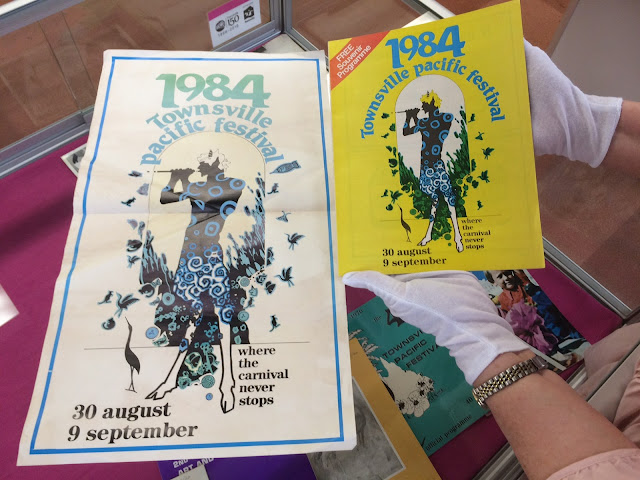 |
| Townsville RailwayStation decorated to celebrate the end of WWII in 1945,Townsville Album, NQ Photographic Collection, NQID 4546. |
VP50 Celebrations
During the years of the Second World War, Townsville was a major staging point for the Allied war effort in the Pacific, and its population swelled from 30,000 to around 100,000 due to the influx of Australian and American service personnel. Approximately 5,000–7,000 citizens voluntarily evacuated the city and those that remained faced a tense time marked by uncertainty and prolonged shortages of basic necessities; with almost every available resource going towards the war effort. Many buildings, including hotels, schools, cinemas and other businesses, as well as private homes, were requisitioned for use by the military. Education was disrupted, and a number of schools were commandeered for military use, and there were drastic shortages of ice, fresh milk, firewood and fuel. Together with inflated prices for fruit and vegetables, these factors contributed to an air of tension between civilians and the military. When the war ended, thousands of people flocked to Flinders Street to celebrate the end of the war. The Townsville Daily Bulletin described the scene:
“Joy ran riot. Knots of citizens of all ages and both sexes intermingled in a jubilant throng. Streamers were soon thrown from the windows; scraps of paper were transformed into confetti and thrown from the first and second floors of buildings. The people wanted to express their joy, their relief, their exhilaration that the long years of anxiety, uncertainty and danger had passed.”
 |
| End of WWII Celebrations, taken from the corner of Stokes & Flinders St, 1945 Ron Aitken Album, NQ Photographic Collection, NQID 2092 |
The “VP50 Celebrations Archive” includes commemorative newspapers, brochures, souvenirs; information on events and concerts; VP50 display materials, historical photographs; an original special feature: “Townsville Victory Day Celebrations / Townsville on Victory Night”, in the Townsville Daily Bulletin, 12 June, 1946; and a VP50 commemorative photo album featuring colour portraits of children with the title “Our Future” embossed on the cover and a heading inside: “Children of the VP50 Celebrations”.
 |
| Title page of "Children of the VP50 Celebrations" book from the VP50 Celebrations Archive, Library Archives Collection. |
The inaugural Townsville Pacific Festival, held in Townsville in June 1970, was a ten-day celebration that focused on cultural, artistic and environmental aspects of life in Pacific countries. One of the main aims of the festival was to create greater friendship and understanding between Australia and other countries in the Pacific region, while at the same time, promoting Townsville on an international stage.
The Festival treated locals and visitors to a smorgasbord of activities and events that included open-air music concerts, cultural displays, theatre productions, Mardi Gras, and sporting competitions. The Festival also fostered local artistic talent, and many artists entered their work in the Art Awards, with categories that included painting, pottery, fibre, photography and gem and jewellery design. Undoubtedly, the Townsville Pacific Festival’s signature event was the iconic street procession of elaborately decorated floats that represented local businesses and community organisations. Successive parades were witnessed by thousands of locals who packed the route along The Strand and through the streets of the central business district.
 |
| Poster and Programme from the Townsville Pacific Festival Archive, Library Archives Collection. |
Festival of the Pacific Arts
The first Festival of Pacific Arts was held in Suva, Fiji, from 6-20 May 1972. In 1988, Australia hosted the fifth Festival of Pacific Arts in Townsville, from 14-27 August, which attracted more than 1,700 participants from 24 countries and territories. With nine performance venues, the city was able to host a variety of events which included story-telling, chanting, poetry reading, a craft village, and film screenings. The festival also hosted a cultural forum, held over five mornings at JCU, which discussed issues such as economic development, land use, cultural maintenance, tourism and self-determination. Held every four years, the festival brings together Pacific peoples from approximately thirty countries to share and exchange culture and, since the first festival was held in 1972, the number of participants has steadily increased to number in the thousands. The aim of the festival has been to “combat the erosion of traditional customary practices,” and emerged from the desire of Pacific leaders to foster friendship and deeper understanding between countries.
 |
| Printed ephemera from the Pacfici Arts Festival Archive, Library Archives Collection. |
This round of displays will continue until Sunday the 3rd of July.


Comments